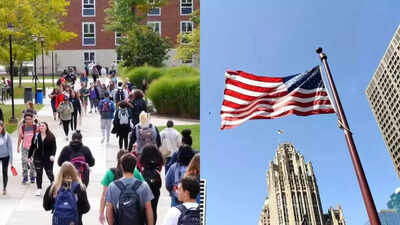ARTICLE AD BOX

One international student after another told the University of Central Missouri this summer that they couldn’t get a visa, many couldn’t even land an interview. The result was striking: Despite demand holding steady, barely half as many new international graduate students showed up for fall classes compared to last year, according to the Associated Press (AP).For Central Missouri, a small public university running on slim margins with an endowment of just USD 65 million, the loss stings. International students typically make up nearly a quarter of its tuition revenue. “We aren’t able to subsidise domestic students as much when we have fewer international students who are bringing revenue to us,” university president Roger Best told AP.The story is not Missouri’s alone. Across the US, colleges that rely on foreign students are confronting an uncomfortable question: What happens to their balance sheets, their campuses, and their futures if visas keep drying up?
Visa politics and campus fallout
Signs of a decline in international enrolments have rattled universities nationwide. An AP analysis found that at least 100 colleges where international students make up 20% or more of enrolment have endowments of less than USD 250,000 per student, leaving them with little financial cushion.
Many are small Christian institutions, though the list also includes bigger names like Northeastern and Carnegie Mellon.Forecasts suggest that the drop in enrolments could reach as high as 40% in some cases, a seismic shift that would not only shake university budgets but also ripple across the wider US economy.Driving this shift is a policy backdrop that has grown steadily harsher. President Donald Trump has pressed universities to limit their intake of foreign students while tightening scrutiny of student visas.
His administration temporarily froze visa appointments, ramped up social media vetting, and even moved to deport students engaged in pro-Palestinian activism. The Department of Homeland Security has signaled plans to further restrict the length of time foreign students can stay in the country.“Policies like these introduce severe financial instability for colleges,” Justin Gest, a professor at George Mason University who studies immigration politics, told AP.
Students in limbo
For many students, the impact is personal and immediate.Ahmed Ahmed, a 19-year-old from Sudan, nearly missed his chance to begin freshman year at the University of Rochester. In June, the Trump administration announced a travel ban on 12 countries, including Sudan. Although Ahmed had already secured his visa, he was denied boarding in Uganda while attempting to fly to the US.Only with the intervention of Rochester’s international office did he finally make it onto another flight. Now studying electrical engineering on a scholarship, Ahmed told AP he feels supported on campus but is acutely aware of the risks.
“I feel like I made it through, but I’m one of the last people to make it through,” he said.His story captures the growing hesitation among international students who must navigate uncertainty, bureaucracy, and the fear of being turned away despite meeting requirements.
Dollars and dependence
For universities, the economics are unavoidable. Unlike domestic students, foreign students are not eligible for federal financial aid and often pay full tuition, sometimes double or triple the in-state rate.“To put it more dollars and cents-wise, if an international student comes in and pays USD 80,000 a year in tuition, that gives universities the flexibility to offer lower fees and more scholarship money to American students,” Gest explained to AP.At Central Missouri, international students have historically accounted for about 30% of enrolment. Facing the downturn, the school has frozen cost-of-living raises for employees, delayed infrastructure upgrades, and begun searching for other ways to cut costs.Smaller institutions are especially vulnerable. Lee University in Tennessee, a Christian liberal arts school with just 3,500 students, expects 50 to 60 international students this fall, down from 82 last year. That drop alone represents a significant financial loss, director of graduate studies Roy Y. Chan told AP. Lee has already raised tuition by 20% over the past five years to make up for declining enrolment.“Since we’re a smaller liberal arts campus, tuition cost is our main, primary revenue,” Chan said. “We don’t have the government funding or major donations that others do.”
The bigger picture
The strains on international enrolments add to the distress of colleges already on the brink. For institutions that depend on foreign students for survival, the tightening of US visa rules is not just a matter of admissions, it’s a question of long-term viability.As Ahmed’s journey shows, the hurdles extend far beyond paperwork; they shape whether talented young people even choose the US at all. For American campuses, especially the smaller ones, the choice is stark: Adapt to a future with fewer international students, or risk being pulled under as their global lifeline dries up.TOI Education is on WhatsApp now. Follow us here.



.png)
.png)
.png)
















 19 hours ago
4
19 hours ago
4








 English (US) ·
English (US) ·